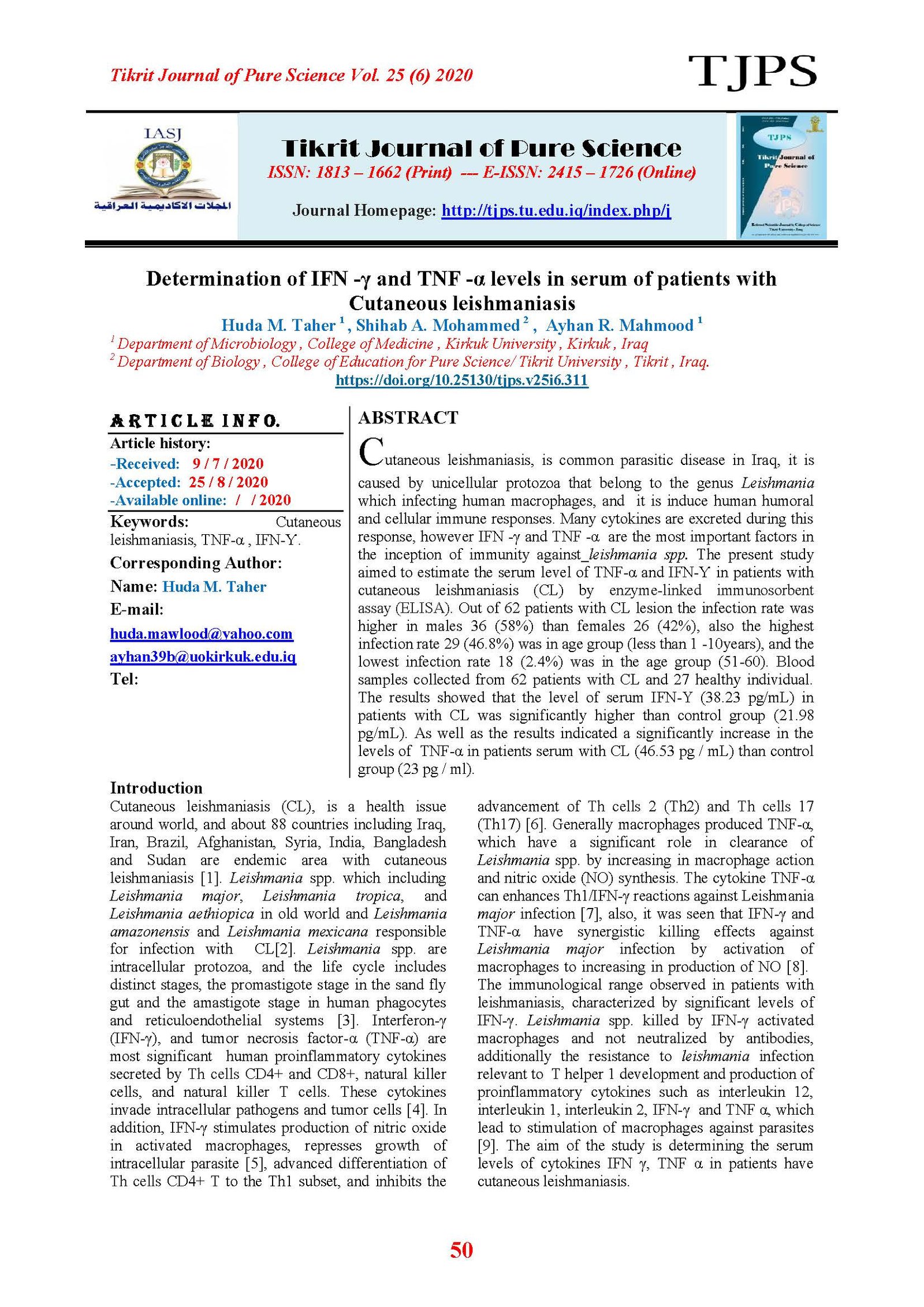Determination of IFN -γ and TNF -α levels in serum of patients with Cutaneous leishmaniasis
Main Article Content
Abstract
Cutaneous leishmaniasis, is common parasitic disease in Iraq, it is caused by unicellular protozoa that belong to the genus Leishmania which infecting human macrophages, and it is induce human humoral and cellular immune responses. Many cytokines are excreted during this response, however IFN -γ and TNF -α are the most important factors in the inception of immunity against leishmania spp. The present study aimed to estimate the serum level of TNF-α and IFN-Ƴ in patients with cutaneous leishmaniasis (CL) by enzyme-linked immunosorbent assay (ELISA). Out of 62 patients with CL lesion the infection rate was higher in males 36 (58%) than females 26 (42%), also the highest infection rate 29 (46.8%) was in age group (less than 1 -10years), and the lowest infection rate 18 (2.4%) was in the age group (51-60). Blood samples collected from 62 patients with CL and 27 healthy individual. The results showed that the level of serum IFN-Y (38.23 pg/mL) in patients with CL was significantly higher than control group (21.98 pg/mL). As well as the results indicated a significantly increase in the levels of TNF-α in patients serum with CL (46.53 pg / mL) than control group (23 pg / ml).
Article Details

This work is licensed under a Creative Commons Attribution 4.0 International License.
Tikrit Journal of Pure Science is licensed under the Creative Commons Attribution 4.0 International License, which allows users to copy, create extracts, abstracts, and new works from the article, alter and revise the article, and make commercial use of the article (including reuse and/or resale of the article by commercial entities), provided the user gives appropriate credit (with a link to the formal publication through the relevant DOI), provides a link to the license, indicates if changes were made, and the licensor is not represented as endorsing the use made of the work. The authors hold the copyright for their published work on the Tikrit J. Pure Sci. website, while Tikrit J. Pure Sci. is responsible for appreciate citation of their work, which is released under CC-BY-4.0, enabling the unrestricted use, distribution, and reproduction of an article in any medium, provided that the original work is properly cited.
References
[1] World Health Organization, Regional Office for Europe. (2014). Strategic
framework for leishmaniasis control in the WHO European Region 2010-2014.
[2] Igbineweka, O.; Aghedo, F.; Idusuyi, O. and Hussain, N. (2012). Evaluating the efficacy of topical silver nitrate and intramuscular antimonial drugs in the treatment of cutaneous leishmaniasis in sokoto, Nigeria. Afr. J. Clin. Exp. Microbiol. 13:90 - 97.
[3] Murray, H.W.; Berman, J.D. Davies, C.R. and Saravia, N.G. )2005(. Advances in leishmaniasis. Lancet. 366: 1561–1577.
[4] Schoenborn, J.R. ana Wilson, C.B. ( (. 2007 Regulation of interferon-gamma during innate and adaptive immune responses. Adv. Immunol. 96:41– 101.
[5] Sharma, U. ana Singh, S.( 2009). Immunobiology of leishmaniasis. Indian J Exp Biol. , 47(6):412–23.
[6] Alexander, J. ;Satoskar, A.and Raan Russell, D.G. (1999). Leishmania species: models of intracellular parasitism. J Cell Sci. 112(18):2993–3002.
[7] Liew, F.Y; Wei, X.Q ana Proudfoot L. (1997). Cytokines and nitric oxide as effector molecules against parasitic infections. Philos Trans R Soc Lond B Biol Sci. 352(1359):1311–15.
[8] Liew, FY; Li Y and Millott S.(1990). Tumor necrosis factor-alpha synergizes with IFN-gamma in mediating killing of Leishmania major through the induction of nitric oxide. J Immunol. 145(12):4306–10.
[9] Sacks D . ana Noben - Trauth N. )2002( The immunology of susceptibility and resistance to Leishmania major in mice. Nat Rev Immunol. 2 (11):845–58.
[10] Colle, J.; Fraser, A.; Marmion, B. and Simmans, A. (1996). Mackie Macdinay practical medical microbiology 14th . Ed. Churchill Livingstone. New York, USA., PP. 721-75
[11] Weina, P.J.; Neafie, R.C.; Wortmann, G.; Polhemus, M. and Aronson, N.E. )2004(. Old World Leishmaniasis: An Emerging Infection among Deployed US Military and Civilian Workers. Clinical Infectious Diseases, 39: 1674–1680.
[12] AL-Samarai, A.M. and Al-Obaidi, H.S. (2009). Cutaneous Leishmaniasis in Iraq. J.Infect. Developing Countries, 3(2):123-129.
[13] Arroub, H.; Alaoui, A. and Habbari K. (2010). Eco-Epidemiologique la Leishmaniose Cutanée dans la Région de Foum Jamâa (Azilal, Maroc). Rabat, Maroco: Le Premier Colloque International sur les Changements Climatiques ET Environnement, Faculté. Des. Sciences.
[14] Rahi, A. A.; Nsaif, S.; Hassoni, J. J.; Magda, A. A. and Hamza, H. (2013). Comparison of diagnostic methods in Cutaneous Leishmaniasis in Iraq. Am. J. Bio., 1(1): 1-5.
[15] Gomes , N. A. and Dos, R. (1998): Unresponsive CD4 T - lymphocyte from Leishmania chagasi infected mice increase cytokine production and mediate parasite killing after blockade of B7 - 1/CTL - A molecular pathway . J. Infect. Dis. 8:178 - 184 .
[16] Sharma, U.ana Singh, S.(2009). Immunobiology of leishmaniasis. Indian J Exp Biol. 47(6):412–23.
[17] Schoenborn, J. R. and Wilson C.B.(2007). Regulation of interferon-gamma during innate and adaptive immune responses. Adv Immunol. 96:41– 101.
